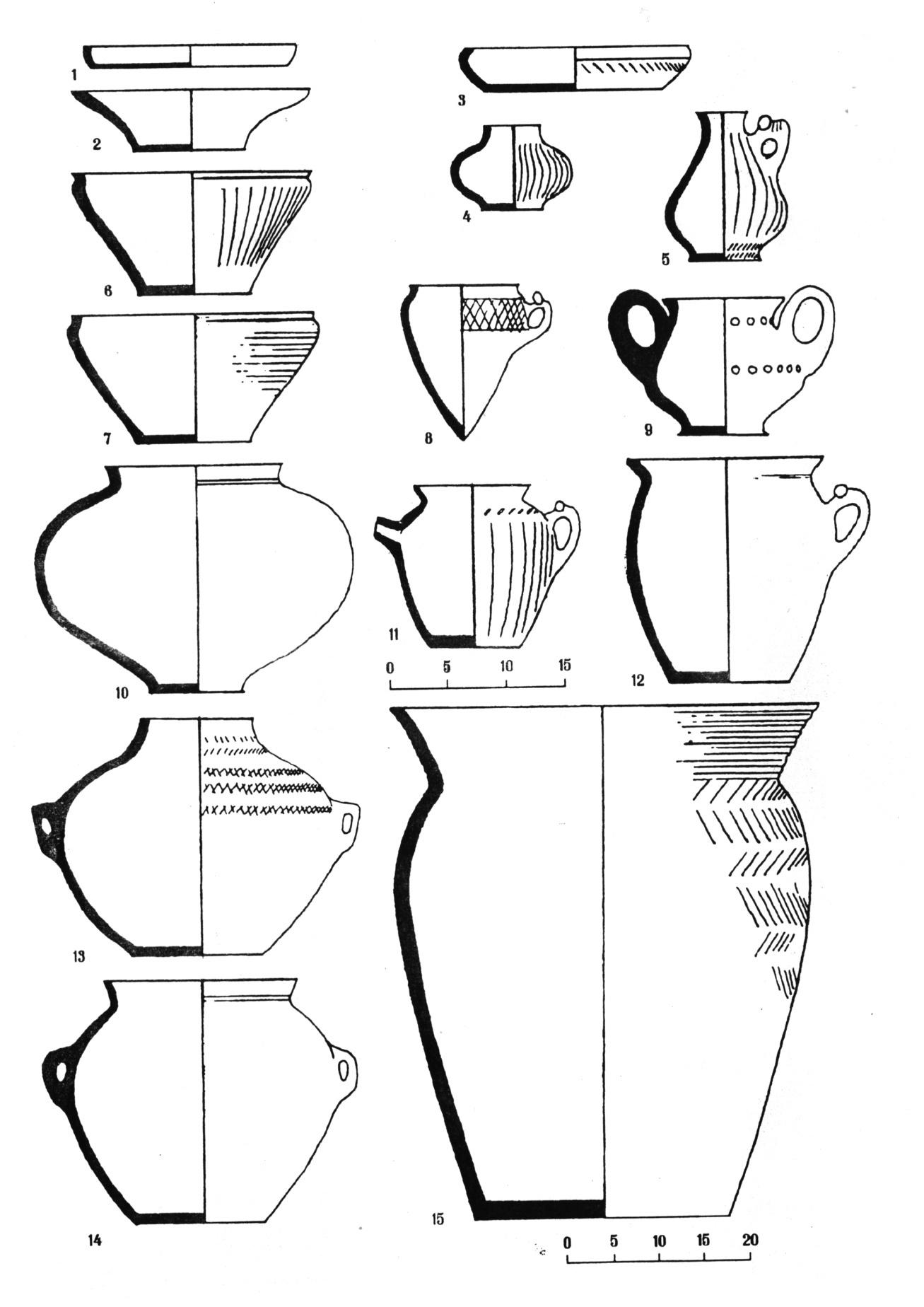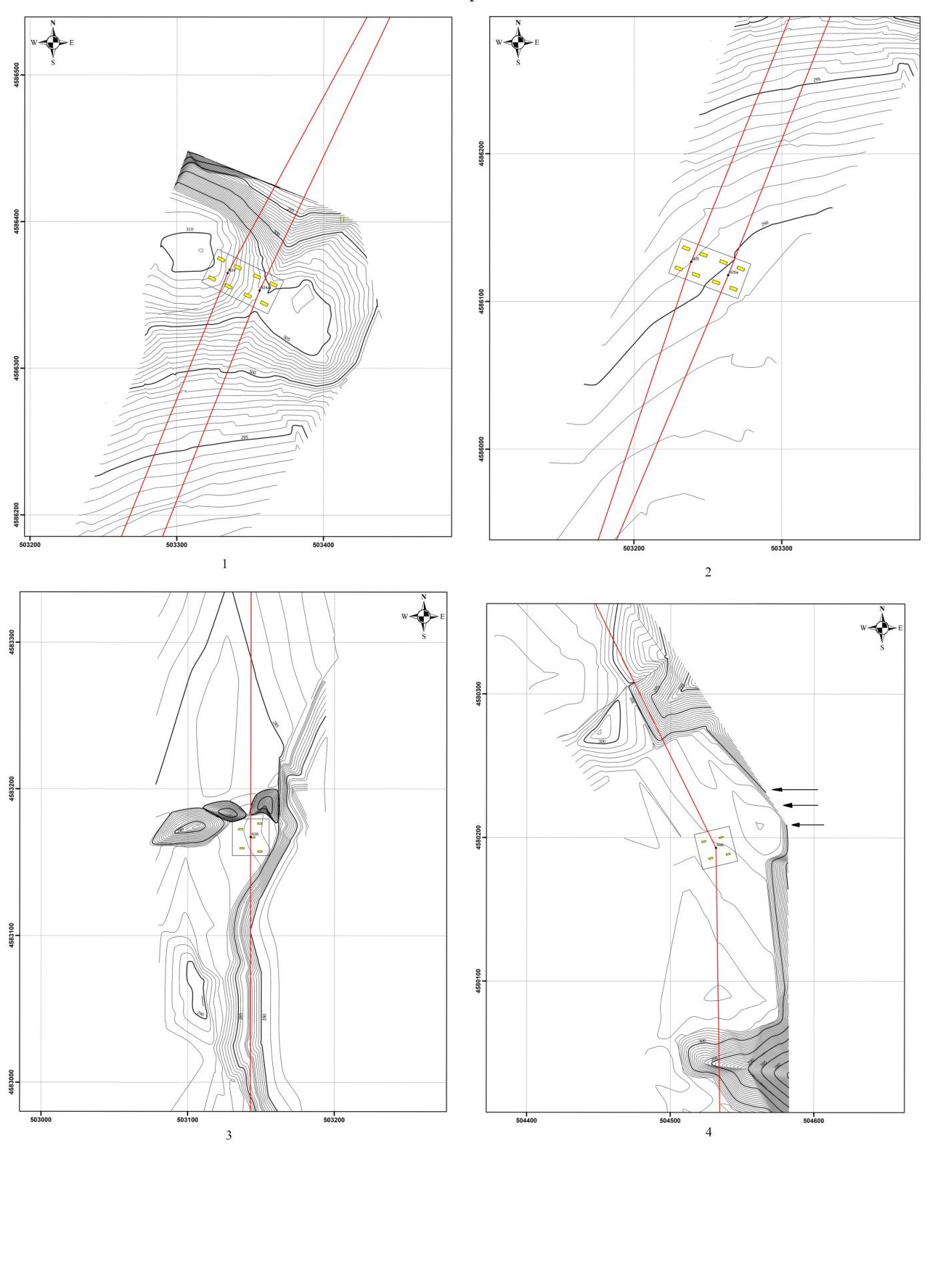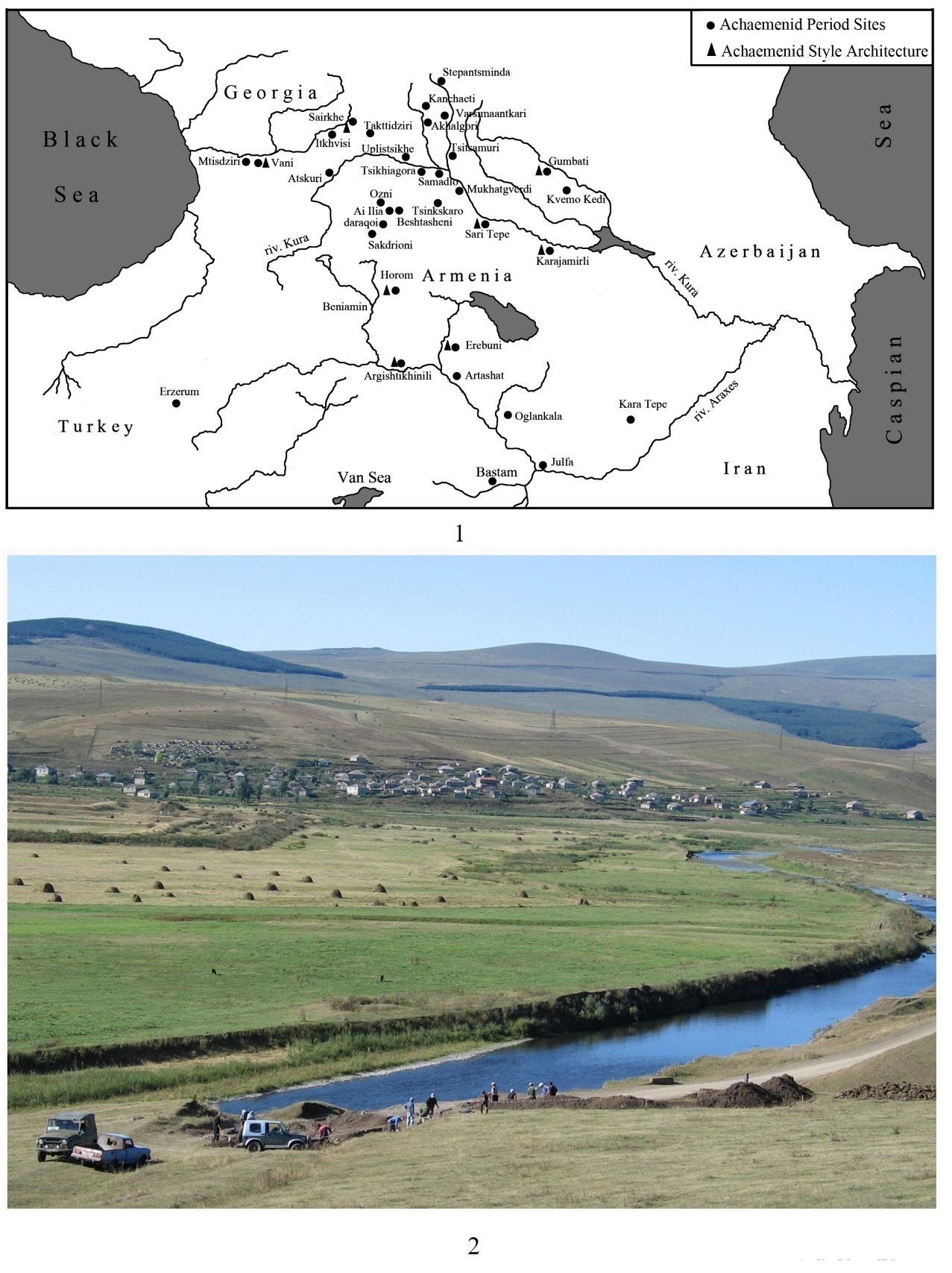
37 minute read
Narimanishvili G., Shanshashvili N. House and Household in South Georgian Highlands (Trialeti) in 5th – 4th cc. B.C
Goderdzi Narimanishvili, Nino Shanshashvili Georgian National Museum (Georgia, Tbilisi)
House and Household in South Georgian Highlands (Trialeti) in 5th – 4th cc. B.C.
Advertisement
In the 5th – 4th centuries B.C. Trialeti used to be densely populated area in South Georgia. First studies of the sites of this period were conducted by B. Kuftin, who, in 30s’ and 40s’ of 20th century, excavated cemeteries in villages Beshtasheni, Kushchi, Karyak, Dash-Bash and Avranlo1. Contemporary settlements of those cemeteries were not discovered for a long time. Only in 1998 Trialeti Archaeological Expedition discovered the settlement of 5th and 4th cc. B.C. near the village Darakoi and on the mountain Ai-Ilia. Later three settlements (Darakoi, Ai-Ilia, Sakdrioni) were partly excavated2 .
Choosing household in Trialeti was mainly determined by a landscape and natural conditions. In the 1st mill. B.C. in Trialeti we see at least two landscape types – mountain valleys and forest. Such landscape is different from the recent landscape conditions of the region, which is characterized by poorness of forest biotypes.
Basing on palynological data, in the last 15000 years on Tsalka plateau 10 different phases of landscape development were distinguished. 15th – 6th cc. B.C. coincides with the eighth phase, when happens warming of climate. Warming continued till 5th c. B.C. when a cold spell of subatlanic period started, which also was of a global character. Period from the 5th c. B.C. is characterized by a worsening of natural conditions, which continued for several centuries3 . It must be mentioned, that from the 5th c. B.C. number of archaeological sites in the region start to decrease. Important is that in the end of the 1st mill. B.C. we find just two settlements (Beshtasheni and Santa).
Worsening of the climate conditions is well shown in the palynospectre of Ai-Ilia mountain settlement. There is no warm-lower plants like lime-tree between trees and we see decrease of number of sowing seeds as well as there is not cultivated vine at all. Cattle-breeding had have a main role in the household4. Paleozoological and paleobotanical analysis shows us that that the conditions of the functioning of the Trialeti 1st mill. sites and the conditions of the landscape in resent are different. Landscape of Trialeti determined a choice of area of household. Recent settlements are situated on the banks of the rivers or on the law slopes, where, on one side there are pastures and hayfields and on the other side arable lands.
1. Boris Kuftin, Arkheologicheskie raskopki v Trialeti (Archaeological Excavation in Trialeti). Tbilisi: Publishing House of the Academy of Sciences of the Georgian SSR, 1941;Boris Kuftin, Arkheologicheskie raskopki v Tsalkskom raione (Archaeological excavation in Tsalka region). Tbilisi: Izdatelstvo akademii nauk gruzinskoi ssr, 1948. 2. Goderdzi Narimanishvili, „Darakois namosaxlari da samkhret kavkasiis akemeniduri khanis istoriis zogierti sakitxi“ (Daraqoi Settlement and some Patterns of History of Achaemenid Epoch Transcaucasus). Iberia-Colchis. Researches on the Archaeology and History of Georgia in the Classical and Early Medieval Period. 5 (2009): 94-125. 3. Eliso Kvavadze et al. „Pozdnepleistocenovaya i golocenovaya istoria razvitia landshaftov Tsalki (Ujnaya Gruzia) po palinologicheskim dannim ozernikh i pochvennikh obrazovanii (Late Pleistocene and Holocene History of Landscapes of Tsalka Plateau (Soutern Georgia), based on Palynological Analysis of Lake and soil Formations) Problems of Paleobiology, II (2007),Georgian national Museum:12-22. 4. Eliso Kvavadze and Goderdzi Narimanishvili, “The palaeolandscapes of the Tsalka Plateau in the Late Pleistocene and Holocene”, in Rescue Archaeology in Georgia: The Baku-Tbilisi-Ceihan and South Caucasian pipelines, editor in-chief Gela Gamkrelidze. (Tbilisi, Georgian National Museum, 2010), 580.
The oldest settlements also were placed on the banks of the rivers. Palynological research shows us that the half of the fields surrounding the settlements were used as arable lands and the other half as a pastures. Near the settlements there were growing silver birches, nut-trees and hazel nut-trees. In the region there were forests or big copses where oaks, alder-trees and elms were grown. Settlements in the 5th – 4th cc. B.C. were situated on the second or the third terrace from the river, but rarely people lived on the lowest, the first terrace.
In 2003-2008 5th – 4th cc. B.C. Darakoi, Sakdrioni and Ai-Ilia settlements were studied by Tsalka-Trialeti Archaeological expedition5 .
Darakoi settlement. Village Darakoi is situated in Kvemo Kartli on the southern slopes of Trialeti mountain range, in Tsalka Municipality, north-east from Tsalka town in 15 km. Darakoi settlement occupied 2.5 hectares and only 300 square meters were excavated, where 9 houses, 20 storage pits and 2 pits for grain were discovered. Walls of the houses were built with crude or lightly treated stones. Length of the walls of Darakoi houses is 5 -7 meters and width 4 – 6 meters. The houses had a flat roof, which was based on a wooden pillars standing along the walls and in the center of the room. Interior of the excavated houses in Darakoi is simple. One part of the floor was paved with basalt slabs and another part was plastered with clay. The Altar was placed in the center of the room or attached to the wall.
There were discovered two types of altars in the settlement. One type is clay made and another one is constructed from the stones. The best preserved altar is from the house # 1. It has prolonged form with length 2.72. m width 1.12 m and height 0.48 m. The altar is constructed form stones and clay and its surface is plastered with clay. A shelf (bench) is attached to the altar form the northern side. The shelf (bench) is set against the western wall. Similar benches were discovered in every room. In the part where the floor is paved with stone slabs is placed a bed, its length is 2.5 m and width 1.2 m. Bed is constructed form the more massive stones than those of the floor slabs.
In the corner of the room there is placed two-leafed oven for bread baking. The best preserved oven was discovered in house # 5. Length of its façade is 1.3 meters, height 0.75 meters and width 0.9 meters. The oven is made of stone slabs with clay mortar and is covered with big stone stab which is placed on three vertical stone slabs. Floor in the fire-chamber and baking place is plastered with clay. Cut of the baking place show us that the lower level was filled with clay and pebble. This level was plastered with clay and covered with ceramic pieces of different sizes and forms. In the oven there were three levels of thermo-insulation. Darakoi houses were renewed. During the renovation the damaged part of wall was left in its place and the new wall was built at the expanse of the interior. As it seems the floor was renovated in the same time.
The main part of the discovered materials are clay vessels. Only several metal objects were discovered on the site. During the excavations many agricultural tools were discovered, what indicates the high level of agricultural development of the population. In every house there were discovered hand-mills, grind stones and mashers made of tuff, basalt and cobblestone.
Darakoi settlement contained two cultural layers and several horizons. Upper layer is represented with cult buildings, living houses and storages as well as several storage pits. Big part of storage pits is in the lower layer. The upper layer of the settlement, basing on the materials discovered in houses and storage pits, is dated form the middle of the 5th – 4th cc. B.C. and the lower layer is dated form the 6th c. B.C.
Sakdrioni settlement is situated south from the Darakoi settlement, on the opposite side of Tsalka reservoir. The settlement is situated on a slope which sets against the right bank of Ktsia
5. Narimanishvili, „Darakois namosaxlari“, 94-125.
river form the northern side. Settlement is situated on 1520 meters above sea level, west form the village Sakdrioni (Edi Kilisa in the past). The length of the settlement on the east-west line is 1000 meters and on the north-south one 800 meters. Three buildings were excavated on the settlement. Houses are built form big and middle sized basalt stones. There are preserved 5-6 rows of the walls. Floors of the buildings are plastered with clay or paved with big stone slabs. At the western wall of the house #1 were discovered two full skeletons of sacrificed piglets, one was placed on a bench (altar?) and another one in a nearby hollow. At the necks of the piglets clay pendants were discovered.
At the eastern wall of the same house a strongly damaged oven, its proportions are 0.8 X 0.8 meters. On the oven a small oil-lamp was discovered and fragments of pen like vessel were found near it. Four storage pits were excavated in the house. Along with the ceramics in the houses were discovered: obsidian nucleus, pendant made form a phalanx of a small cattle, bronze bracelet, bronze ring, clay pendant, obsidian flakes, cobblestone grind stones and basalt hand-mills.
Osteological materials indicate that that the main food of the local population used to be meat and animal products. Here were discovered remnants of bones of different animals like chicken, pig, sheep, goat and cattle and well as fish bones. Sakdrioni settlement contains two cultural layers and several horizons. Upper layer belongs to the Hellenistic Period (3rd – 1st cc. B.C.) and the lower one is dated from the 5th – 4th cc. B.C.
Ai-Ilia settlement is situated in Trialeti in 3 km west from the village Beshtasheni, on Ai-Ilia mountain range. This range lies between Beshtasheni and Santa villages along the Tsalka reservoir. On the top and slopes of the mountain “cyclopean” stronghold, settlement and man-made terraces are situated. The “cyclopean” stronghold is surrounded by a Late Bronze Age settlement. West form the stronghold the oldest layers were discovered; they do belong to the Late Mesolithic or Early Eneolithic periods.
A big architectural complex of 5th – 4th cc. B.C. is situated in the southern part of the top of the mountain, in 150 meters south from the “cyclopean” stronghold and 200 meters east from the Early Eneolithic site. Supposed length of the complex was 70 meters and width 25 meters. Complete area of the building is 1700 – 1800 square meters. Complex contains 15 storages (number of the storages was determined only by visual observation), 8 of them are well preserved and another 7 ones are strongly damaged. It is important to mention the regular disposition of the complex planning.
The complex was built according to one, preliminarily worked out plan. From the all four sides it is surrounded by massive 4 – 5 meters thick walls. Thickness of the walls between the storages reaches 2 – 3 meters. Wall are built from big, partly treated basalt stones. One sided laying is constructed from several rows of horizontally placed stones. Room between the side stones was filled with small stones and as it seems with mud as well. Exactly this is the main difference between the building technique of Ai-Ilia big complex and Trialeti “cyclopean” buildings which are built with dry masonry.
There are not discovered any remnants of other buildings near the complex. In 2005 one storage was excavates, it is 9.0 meters long and 9.0 meters in width. Preserved height of the walls reaches 1.5 – 1.8 meters. The house had a flat roof, which was based on stone walls and four pillars in the center of the house. Floor of the house used to be plastered with clay. Along the northern wall of the room, in its central part, a bench with high back was constructed form the big stone slabs. The bench is places 0.5 meter far from the northern wall and is separated from the floor with one stepped podium. Length of the bench is 3.5 meters and the width reaches 1.75 meters. Width of the sitting place is 0.8 meter and the height of the back reaches 0.4 – 0.5 meter.
Height of the sitting place form the podium is 0.4 – 0.45 meter, the height of the podium from the floor level is 0.2 – 0.25 meter and its width 0.95 meter. It is possible for four, maximum five persons to sit on the bench. Along the eastern and western walls there are narrow “benches” or “chairs” constructed from stone slabs. Unlike the central bench they are directly attached to the walls and do not have podiums and backs. Persons who sit on these benches have to lean against the wall and place their feet on the floor. These benches are similar to each other, their length is 4.7 meters and width 0.4 – 0.6 meter. On each one 7 – 8 persons can sit in the same time.
North-western and south-eastern corners of the room are constructed differently. In the north-western corner a short bench with back is placed, in the opposite, north-eastern corner an oven is constructed. Bench in the north-western corner lies ling the western wall, its length is 2.25 meters and the height of the back reaches 0.5 meter. This bench does not have a podium. Three or four persons can sit on it in the same time. Direct extension of this bench along the wall is another bench without back. In the north-eastern corner of the room, there is constructed a big oven with two sections. Both sections are built with big basalt slabs. The oven was covered with one big basalt slab. Thermo-insulation of the oven was made with high quality clay and pieces of ceramics. Chimney was built inside the wall, thus could not be seen from the interior. Length of the oven is 1.8 meter, its deep 1.5 meter and the height supposedly was 1.0 – 1.1 meter. From the south an ash box is attached to the oven. The length of the box is 1.1 meter, width 0.8 meter and its height reaches 0.5 meter. A sitting bench is attached directly to the oven and the ash box.
As we have mentioned, on the top of the Ai-Ilia mountain there was built only one complex and not a settlement. It is important that the building, which we have excavated is different from other contemporary buildings not only in Trialeti or Kvemo Kartli, but also in whole South Caucasus. This fact indicates the different function of the site.
Today it is hard to discuss the function of Ai-Ilia complex, because its main part is not studied yet. Though, it must be mentioned that the interior of the room is directed to the bench at the northern wall, which dominates the whole interior. The inner space is organized in the way that the central part of the room is totally free. Benches along the walls are directed to the centre of the room, where supposedly, the main actions had place. Basing on the abovementioned facts we can say that the room was not used as a living space.
We believe that the building, which was excavated in 2005 used to be place of public meetings. Special sitting places and benches along the walls indicate that some number of people used to gather here. It is important to mention that the organization of the interior indicate the existence of complex social hierarchy. It seems, that in the society, which used to gather in Ai-Ilia complex, the highest rank holds persons who set on the beeches with podium and back at the northern wall, persons with next, lower rank set on the bench with back at the north-western corner, person who hold third place in the hierarchy set on the benches at the eastern and western walls.
It hard to say why there were no benches at the southern wall, what was placed there or who used to occupy this place. Also it is hard to say wat was the function of the center of the room. Excavation of only one room of Ai-Ilia complex does not answer many questions. Though the discovered materials and the received information is very important for study of history of Trialeti and South Caucasus of 5th – 4th cc. B.C.
Basing on the data received form the 5th – 4th cc. B.C. settlements in Trialeti we can say that the settlements of this period occupied 2 – 5 hectares. Houses were placed on a low terrace (Darakoi, Sakdrioni). Living area used to be represented with one big room. Interior of the houses was simple. In one corner an oven used to be constructed, along one of the walls there was a bed made from clay or stones and the floor was plastered with clay. Ceramics discovered in the houses is kitchenware and the number of household vessels is small.
It must be mentioned, that in each house was constructed small or middle sized altar. As it seems some rituals were conducted in the houses. One part of the houses (Ai-Ilia, Darakoi house # 1) used to be places for public meetings. In these houses long benches are constructed along the walls. As it seems Darakoi house used to be some kind of chapel, in the center is placed a big altar and a fire was burnt on it. In the building excavated in Ai-Ilia complex no altar was discovered, neither there were found fragments of ceramic vessels (they were used only in thermo-insulation of the oven). Though it was place for public meetings for sure. Its exact function, supposedly, will be defined after complete excavation of the complex.
Interesting information about household of 5th – 4th cc. B.C. Trialeti was received after paleozoological and palynological studies. If was find out that main food of the Darakoi population used to be meat and animal products. Here were discovered remnants of bones of different animals like chicken, pig, sheep, goat buffalo and cattle and well as bones of wild animals like fox, badger, bear, roe deer and stag. Also there were discovered several bones of a bird, lower jaw of a field vole and one fish bone. Discovery of donkey and horse bones in the settlement indicate that these animals were used as a draught animal. Also it is interesting that a skeleton of a dog was discovered in the cultural layers of the settlement.
Settlements which we excavated do not answer the question: where and in what conditions were the animals kept, but we can say that they were far from the houses.
Palynological research indicate the intense agricultural activities of Darakoi population. Several breeds of wheat, barley, rye, oat, millet and Italian millet used to be sowed there. Though the most popular was wheat. Population did also cultivate a flax. Palynological spectrum did not find any sign of vine-growing or gardening. Along with arable farming a cattle breeding seems to be well developed there. This fact is indicated by discovery of big amount of weeds typical for pastures and dung mushrooms as well as leather beetles, indumenta of moth larva and sheep fleece. Composition of palynological complex and heart wood cells of trees and plants show us that in the discussed period a forest was growing around Darakoi. The forest was manly composed from pine-trees, but also included oaks, maples, and elms. Along the rivers alders were growing. Palynological study showed us that in this period the climate was not too warm, which made difficult to develop vine-grooving and gardening.
Most of the artifacts discovered in the settlements Darakoi, Sakdrioni and Ai-Ila, are pottery. Ceramics is distinguished by its abundance and diversity. One group of ware is made of well-sedimentary clay, thin-walled and produced on a potter’s wheel. It is black. The second group of ceramics is also made of well-sedimentary clay and is thin-walled. This pottery is red. The surface of the ware of this group is well processed, polished, or decorated with relief ornament. Part of this pottery is painted in red, or ornamented.
Among the materials discovered in Ai-Ilia, Darakoi and Sakdrioni settlements a special attention must be payed to the red-clay pottery. Part of this pottery is painted or ornamented in red. Spread of “triangle ware” style pottery in Kartli is explained by the influence of Achaemeniad Iran.
At the Darakoi settlement, like the sites of 5th-4th cc. BC of Kartli (Iberia), the specific, kettle-like vessels, typical for the Iranian world were found, the red colored and ornamented pottery begins to spread at the same period.
The vast majority of pottery found at the settlements is painted in red. Among the materials discovered in Darakoi settlement, special attention deserves vessels, painted and ornamented in red. Theywere produced under influence of pottery “painted with triangles”, which was spread on the territory of Achaemenid Iran.
The oldest specimens of painted ceramics on the territory of Georgia were found on the sites of Kura-Arax culture6. At the beginning of the 2nd millennium B.C. painted pottery widely spread on the sites of Trialeti culture7. In the later period, for almost a thousand years, there is no signs of such pottery. After a long pause in the territory of Kartli painted pottery appeared in the Achaemenid era and in the 4th – 3rd centuries. B.C. spread so widely, that in scientific literature this period is defined as the era of painted ceramics8. Since the 2nd century B.C. number of this ceramics start to decrease and in the 2nd century A.D. practically disappears.
The vessels, painted in red, discovered at Darakoi and Sakdrioni settlements is similar to the style of the triangles. Archaeologists believe, that the pottery painted with triangles, appears in Kartli from the 5th or 4th centuries B.C. The opinion of scientists is divided on the origin and the ways of distribution of painted pottery. We believe that, the spread of this ornament on the territory of Kartli was determined by two conditions. Distribution of pottery painted and or ornamented in red is certainly a consequence of relations with Achaemenid Iran9. Although local production of such ceramics was contributed by the gray and black ware, which existed in the era of the Late Bronze - Early Iron. These ware was ornamented with glossy or scratched triangles. In our opinion, painted, as well as red ceramics in Kartli appears during the Achaemenid era, when the Achaemenids paid special attention to strengthening the northern borders of the young empire.
In our opinion, the spread of Achaemenid culture in the South Caucasus started after 522521. B.C, when the military activity of the Achaemenids in this direction reached its climax. As it seems in 515 B.C. when Darius captured Thrace and began a campaign in Scythia, the political influence of Achaemenid Iran in the South Caucasus had already been established. It was in this period of time that settlements appeared at the villages of Sakdrioni, Darakoi and on Mount
6. Shanshashvili, Nino and Narimanishvili, George, “Painted Pottery of the Kura-Araxes Culture from the South Caucasus” in International Symposium on East Anatolia South Caucasus Cultures. Proceedings, I (2015), edited by Mehmet Işikli and Birol Can. Cambridge:132-144. 7. Japaridze, Otar, Arkeologiuri gatxrebi Trialetshi (Archaeological Excavation in Trialeti).(Tbilisi: Metsniereba, 1969) 122-147. 8. Gagoshidze, Iulon, Samadlo. Arkheologicheskie raskopki.(Samadlo. Archaeological Excavations) (Tbilisi: Metsniereba,1979) 90. 9. Goderdzi Narimanishvili, Keramika Kartli V-I vv. do n.e. (Keramiks of Kartli V-I cc. B.C.) Tbilisi:Metsniereba, 1991. Goderdzi Narimanishvili, “Iberia da Iranuli samkaro” (Iberia and Iranian World). Scientific Session “World cultural and historical process and Georgia” (1993). Abstracts. Tbilisi, 39-41. Goderdzi Narimanishvili, “Agmosavlet amierkavkasia da iranuli samkaro dzv.ts. V-I ss. (Eastern Transcaucasus and Iranian World in V-I cc. B.C.) II Scientific Session “World cultural and historical process and Georgia” (1994). Abstracts. Tbilisi, 19-22. Goderdzi Narimanishvili, “Darius’s campaign to Scythia and Eastern Transcaucasus.” III Scientific Session “World cultural and historical process and Georgia” (1995). Abstracts. Tbilisi, 17-20. Goderdzi Narimanišvili,“Die Keramik Kartlis (Iberiens) in achaimenidischer und postachaimenilischer Zeit“. Archäologische Mitteilungen aus Iran und Turan. Band 32 (2000): Berlin. 227-242. Goderdzi Narimanishvili and Vakhtang Shatberashvili, `Red-Painted Pottery of the Achaemenid and Post-Achaemenid Periods from Caucasus (Iberia): Stylistic Analysis and Chronology.” Ancient Near Eastern Studies XLI (2004):120-166.
Ai-Ilya Mountain., which existed until the middle of the 4th century. B.C. The stratigraphy of Darakoi settlement and the stylistic-typological analysis of Kartli ceramics showed that the upper layer of the Darakoy settlement dates from the 5th and the middle of the 4th centuries B.C, and the lower layer dates from the 6th century B.C.
The artifacts found in the settlements of Sakdrioni, Darakoi and Ai-Ilya clearly indicate that the painted pottery in Kartli appears if not at the end of the 6th century. B.C, then in the early 5th century B.C. already was in use.
Existence in South Caucasus of strong settlements and strongholds (Erebuni, Benyamin, Karajamirli, Sari-Tepe, Gumbati, Tsikhia-Gora etc.) and other sites, where many Achaemenid and Achaemenid style artifacts were discovered indicates a cultural, economical and political influence of Achaemenid Iran.
Achaemenid influence is clearly noticeable in Trialeti settlements dated to the 5th – 4th cc. B.C. There in the houses, along with the foreign red and painted pottery, appears new elements of the interior. As it seems religion and beliefs started to change that which had an effect on everyday life.
goderZi narimaniSvili, nino SanSaSvili saqarTvelos erovnuli muzeumi (saqarTvelo, Tbilisi)
saxli da saxl-kari Zv.w. V-IV saukuneebis samxreT saqarTvelos mTianeTSi (TrialeTi)
Zv.w. V-IV saukuneebSi TrialeTi samxreT saqarTvelos mWidrod dasaxlebul mxares warmoadgenda. am epoqis Zeglebi pirvelad Seswavlil iqna b. kuftinis mier, romelmac XX s. 30-40-ian wlebSi gaTxara samarovnebi sof. beSTaSenSi, kuSCiSi, kariakSi, daS-baSSi da avranloSi. sinqronuli namosaxlarebi didxans ar iyo cnobili. mxolod 1998 wels TrialeTis arqeologiurma eqspediciam sof. daraqoisTan da ai-ilias mTaze aRmoaCina Zv.w. V-IV ss. namosaxlarebi. sam namosaxlarze (daraqoi, ai-ilia, saydrioni) arqeologiuri gaTxrebic Catarda.
TrialeTSi samosaxlos SerCevas mniSvnelovnad ganapirobebda landSafti da bunebrivi pirobebi. Zv.w. I aTaswleulSi TrialeTSi sul mcire ori landSafturi tipi - mTis velebi da tye arsebobda. amgvari landSafti ki mniSvnelovnad gansxvavdeba regionis Tanamedrove landSafturi pirobebisagan, romelic tyis biotipebis aSkara siRaribiT xasiaTdeba. palinologiur monacemebze dayrdnobiT, walkis platoze ukanaskneli 15000 wlis ganmavlobaSi landSaftis ganviTarebis 10 etapi gamoiyo. Zv.w. XV-VI ss. Seesabameba merve etaps, rodesac xdeba klimatis daTboba. klimatis daTboba grZeldeba Zv.w. V saukunemde, rodesac daiwyo subatlantikuri periodis aciveba, romelic aseve globalur xasiaTs atarebda. Zv.w. V saukunidan dawyebuli periodi xasiaTdeba klimaturi pirobebis mkveTri gauaresebiT, romelic ramdenime saukunis ganmavlobaSi grZeldeboda. aRsaniSnavia, rom regionSi arqeologiuri Zeglebis raodenoba Zv.w. V saukunidan TandaTan mcirdeba. niSandoblivia, rom Zv.w. I aTaswleulis miwurulis mxolod ori namosaxlaria (beSTaSeni, sanTa) mikvleuli. klimaturi pirobebis gauareseba kargadaa naCvenebi ai-ilias mTis namosaxlaris palinospeqtrebSi. xe-mcenareebs Soris ar aris siTbos moyvaruli iseTi mcenare, rogoricaa cacxvi, naklebia saTesi marcvleuli da saerTod ar aris kulturuli vazi. meurneobaSi wamyvani roli ekuTvnis mesaqonleobas. paleozoologiuri da palinologiuri analizi gviCvenebs, rom TrialeTis Zv.w. I aTaswleulis dasaxlebebis funqcionireba da Tanamedrove periodis landSafturi pirobebi garkveulwilad Secvlilia.
TrialeTis landSafti samosaxlo sivrcis SerCevasac ganapirobebda. dRes arsebuli dasaxlebuli punqtebi mdinareTa napirebze, dabal ferdobebze isea ganTavsebuli, rom maT erTis mxriv saZovari da saTibi, meore mxriv ki saxnav-saTesi farTobebi akravs.
uZvelesi dasaxlebebic mdinareTa napirebze yofila ganTavsebuli. palinologiuri kvleva gviCvenebs, rom dasaxlebis axlomdebare mindvrebis naxevari saxnav-saTesad, nawili ki saZovrad gamoiyeneboda; namosaxlaris siaxloves izrdeboda aryis xeebi, kakali da Txili; regionSi ki iyo tyeebi an didi koromebi, sadac muxa, muryani da Tela izrdeboda. Zv.w. V-IV ss-is samosaxloebi ZiriTadad mdinarispira meore an, ufro maRal, mesame terasazea gamarTuli. Tumca, iSviaTad, uSualod mdinareul pirvel terasazec ucxovriaT. 2003-2008 wlebSi walka-TrialeTis arqeologiurma eqspediciam Seiswavla Zv.w. V-IV ss-iT daTariRebuli daraqois, saydrionis da ai-ilias namosaxlarebi. daraqois namosaxlari. sofeli daraqoi mdebareobs qvemo qarTlSi, TrialeTis qedis samxreT ferdobze, walkis municipalitetis teritoriaze, qalaq walkidan Crdilo-dasavleTiT, 15 km-ze. daraqois namosaxlari ikavebda 2.5 ha-s. gaiTxara 300 kv.m farTobi, romelzec ganlagebuli iyo 9 saxli, 20 sameurneo ormo da 2 xaro. saxlebis kedlebi agebuli iyo daumuSavebeli, an odnav damuSavebuli qviT. saxlebis kedlebis sigrZe 5-7 m udris, xolo sigane 4-6 m. kedlebSi SemorCenilia wyobis 2-8 rigi, romlebic aSenebulia didi da saSualo zomis qvebisgan. kedlebis SemorCenili maqsimaluri simaRle 1.8 m udris. saxlebs banuri gadaxurva hqondaT, romelic eyrdnoboda xis boZebs. sayrdeni boZebi idga kedlebis gaswvriv da Senobis centrSi. daraqoiSi gaTxrili saxlebis interieri martivia. iatakis erTi nawili bazaltis filebiT aris mogebuli, meore nawili ki – Tixatkepnilia. sakurTxeveli dgas Senobis centrSi, an kedelTanaa midgmuli. namosaxlarze gaTxrili sakurTxevlebi ori tipisaa. nawili TixiTaa agebuli, meore nawili ki Sedgenilia qvis filebiT. yvelaze ukeT SemorCenilia sakurTxeveli #1 saxlidan. mas wagrZelebuli forma aqvs, romlis sigrZe 2.72 m, sigane 1.12 m, simaRle ki 0.48 m-is tolia. sakurTxeveli qviTa da TixiTaa nagebi. zedapiri alizis xsnariTaa Selesili. sakurTxevels CrdloeTidan Taro (`merxi~) ebjineba, romelic dasavleT kedelzea midgmuli. Taroze riyis qvis sanayebi iyo dawyobili. msgavsi Taroebi yvela saxlSia dadasturebuli. saxlebis im nawilSi, sadac iataki qvis filebiTaa mogebuli, dadasturebulia sareceli, romlis sigrZe 2.5 m, sigane 1.2 m-ia. is nagebia gacilebiT ufro masiuri qvebiT, vidre iatakis filebia.
Senobebis kuTxeSi ganlagebulia puris sacxobi organyofilebiani Rumlebi. yvelaze ukeT SemorCenilia Rumeli #5 saxlidan. misi fasadis simaRle 0.75 m, sigane ki 0.9 m-ia. Rumeli nagebia qvis filebiT Tixis xsnarze. gadaxuruli iyo qvis erTiani filiT, romelic eyrdnoboda vertikalurad Cadgmul qvis sam filas. sacecxle da sacxobi ganyofilebebis iataki TixiTaa molesili. Rumelis sacxob nawilSi gakeTebuli Wrili gviCvenebs, rom qveda done TixiT da riyis wvrili qviTaa Sevsebuli. es done gadalesi-
lia aliziT, romelzec sxvadasxva zomis da formis keramikis fragmentebia dawyobili. RumelSi am teqnikiT gakeTebuli Termoizolaciis sami done dafiqsirda. daraqois saxlebi araerTxel iyo ganaxlebuli. rekonstruqciis dros Zveli kedlis dazianebul nawils adgilze tovebdnen da interieris Semcirebis xarjze agebdnen axal kedlebs. rogorc Cans, amave drosaa ganaxlebuli iatakic. namosaxlarze aRmoCenili artefaqtebis umravlesobas Tixis WurWeli warmoadgens; liTonis iaraRi mcire raodenobiT aRmoCnda. namosaxlaris gaTxrisas mravlad iqna aRmoCenili sameurneo saqmianobasTan dakavSirebuli iaraRebi, rac soflis meurneobis maRal ganviTarebaze miuTiTebs; yvela saxlSi dafiqsirda xelsafqvavebi, sanayebi da sasresebi. isini ZiriTadad tufis, bazaltis da riyis qvisaganaa damzadebuli. daraqois namosaxlari or kulturul fenas da ramdenime samSeneblo horizonts Seicavs. zeda fena sakulto, sacxovrebel, sameurneo nagebobebsa (xaroebi) da sameurneo ormoebis nawiliTaa warmodgenili. qveda fenas sameurneo ormoebis didi nawili miekuTvneba. namosaxlaris zeda fena, saxlebSi, sameurneo ormoebsa da xaroebSi aRmoCenili masalebis mixedviT Zv.w. V-IV ss Sua xanebiT TariRdeba. qveda fena ki Zv.w. VI s-s miekuTvneba. saydrionis namosaxlari mdebareobs daraqois namosaxlaris samxreTiT, walkis wyalsacavis mopirdapire mxares, md. qciis marjvena napirze. reliefi, romelzec ganlagebulia namosaxlari, warmoadgens qanobs, romelic daferdebulia CrdiloeTisaken da md. qciis marjvena napirs ebjineba. namosaxlari zRvis donidan 1520 m-is simaRleze mdebareobs, dRevandeli sof. saydrionis (Zveli edi-qilisa) dasavleTiT, md. qciis marjvena napirze. aRmosavleT-dasavleTis xazze misi sigrZe udris 1000 metrs, CrdiloeT-samxreTis xazze 800 metrs aRemateba. namosaxlarze gaiTxara sami Senoba. saxlebi nagebia didi da saSualo zomis bazaltis fleTili qvebiT. SemorCenilia kedlis wyobis 5-6 rigi. nagebobebs aqvs Tixatkepnili da brtyeli masiuri qvebiT mogebuli iataki. #1 saxlis dasavleT kedelTan gaiTxara Sewiruli ori goWis sruli ConCxi, erTi moTavsebuli iyo baqanze (sakurTxeveli ?), xolo meore iqve arsebul CaRrmavebaSi. goWebis yelTan dafiqsirda Tixis sakidebi. amave saxlis aRmosavleT kedelTan dafiqsirda Zlier dazianebuli Rumeli, romlis zomebia: 0.80 X 0.80 m-ze. Rumelze aRmoCnda mcire zomis Wraqi, iqve dafiqsirda kecisebri WurWlis fragmentebi. saxlSi gaiTxara 4 sameurneo ormo. keramikis garda saxlebSi aRmoCnda: obsidianis nukleusi; wvrilfexa saqonlis falangisagan damzadebuli sakidi; samajuri, brinjaosi, mrgvalganivkveTiani, rkalgaxsnili; brinjaos rgoli, sakidi Tixis, obsidianis anatkecebi, riyis qvis sasresebi da bazaltis xelsafqvavebi. osteologiuri masala miuTiTebs, rom namosaxlarze mcxovrebTa ZiriTad sakvebs warmoadgenda xorci da mecxoveleobis sxva produqtebi, razec
metyvelebs aq aRmoCenili Sinauri cxovelebis mravalricxovani Zvlovani naSTi. namosaxlarze dadasturebulia: qaTami, Rori, cxvari, Txa da msxvilfexa rqosani saqoneli da Tevzis mala. saydrionis namosaxlari or kulturul fenas da ramdenime samSeneblo horizonts Seicavs. zeda fena elinistur epoqas (Zv.w. III-I ss) miekuTneba. qveda fena ki Zv.w. V-IV ss TariRdeba. ai-ilias namosaxlari mdebareobs TrialeTSi, sof. beSTaSenis dasavleTiT, 3 km-is dacilebiT, ai-ilias qedze. mTis Txemi da ferdobebi ukavia `ciklopur~ simagres, namosaxlars da xelovnur terasebs. `ciklopur~ simagres garSemo gvianbrinjaos xanis dasaxleba akravs. `ciklopuri~ simagris dasavleTiT mikvleuli uZvelesi fenebi gvianmezoliTur, Tu adreneoliTur xanas miekuTvneba.
Zv.w. V-IV ss didi arqiteqturuli kompleqsi ai-ilias mTis Txemis ukidures samxreT nawilSi mdebareobs. is `ciklopuri~ simagris samxreTiT 150 m-is da adreneoliTuri xanis sadgomis aRmosavleTiT 200 m-is dacilebiT aris gamarTuli. kompleqsis savaraudo sigrZe 70 m-ia, sigane 25 m. nagebobebis mTliani farTobi 1700-1800 kv. m-ia. kompleqsi 15 saTavsos Seicavs (saTavsoTa raodenoba mxolod vizualuri dakvirvebis Sedegadaa garkveuli), romelTagan 8 kargadaa SemorCenili, 7 ki Zlieraa dazianebuli. aRsaniSnavia kompleqsis gegmarebis regularuli xasiaTi. kompleqsi winaswar SemuSavebuli, erTiani gegmis mixedviT aris agebuli. mas oTxive mxridan masiuri 4-5 m sisqis kedlebi sazRvravs. saTavsoTa gamyofi tixrebis sisqe ki 2-3 m-ia. kedlebi bazaltis didi zomis nawilobriv damuSavebuli lodebiTaa amoyvanili. calpira wyobebi horizontalurad dalagebuli qvebis ramdenime rigisgan Sedgeba. sapire qvebs Soris arsebuli sivrce mcire zomis qvebiT da rogorc Cans, talaxiTaa Sevsebuli. swored es ukanaskneli ganasxvavebs ai-ilias didi kompleqsis mSeneblobis teqnikas TrialeTis `ciklopuri~ nagebobebisagan, romlebic mxolod mSrali wyobiTaa nagebi. kompleqsis maxloblad sxva nagebobebis kvali ar SeimCneva. 2005 wels gaiTxara erTi saTavso, romlis sigrZe da sigane 9.0 m-s, kedlebis SemorCenili simaRle ki 1.5 – 1.8 m-s udris. saxls brtyeli gadaxurva hqonda, romelic eyrdnoboda qviT nageb kedlebs da saxlis centrSi mdgar xis oTx boZs. nagebobis iataki Tixatkepnilia. saTavsos CrdiloeT kedlis gaswvriv, mis centralur nawilSi, qvis filebiT mowyobilia grZeli merxi, maRali sazurgiT. merxi CrdiloeTi kedlidan 0.5 m-iTaa daSorebuli. iatakidan ki gamoyofilia erTsafexuriani podiumiT. merxis saerTo sigrZe 3.5 m-ia, mTliani sigane 1.75 m-s udris. dasajdomis sigane 0.8 m-ia, sazurges simaRle 0.4-0.5 m-ia. dasajdomis simaRle podiumis iatakidan 0.45-0.5 m-ia. TviT podiumis simaRle iatakis donidan 0.2-0.25 m-s udris, sigane ki 0.95 m-ia. am merxze oTxi, maqsimum xuTi personis ganTavsebaa SesaZlebeli.
aRmosavleT da dasavleT kedlis gaswvriv qvis filebiTa da kvadrebiT mowyobilia viwro `merxebi~, Tu `skamebi~. centraluri merxisagan gansxvavebiT, isini uSualod kedlebzea midgmuli. maT ar aqvT calke formirebuli sazurge da podiumi. am merxebze ganTavsebulma personebma sazurged kedeli unda gamoiyenon, fexebi ki pirdapir iatakze moaTavson. kedlebis gaswvriv gamarTuli merxebi erTmaneTis msgavsia. maTi sigrZe 4.7 m-ia, sigane 0.4-0.6 m-s udris. TiToeulze 7-8 personis ganTavseba iqneboda SesaZlebeli. gansxvavebuladaa mowyobili saTavsos Crdilo-dasavleTi da Crdilo-aRmosavleTi kuTxeebi. Crdilo-dasavleT kuTxeSi mokle, zurgiani merxia mowyobili, mis sapirispiro, Crdilo-aRmosavleT kuTxeSi ki Rumelia gamarTuli.
Crdilo-dasavleT kuTxeSi mowyobili zurgiani merxi dasavleT kedels miuyveba. misi sigrZe 2.25 m-ia, sazurges simaRle 0.5 m-s udris. am merxs podiumi ar gaaCnia. am merxze sami an oTxi personis ganTavsebaa SesaZlebeli. zurgiani merxis uSualo gagrZelebas warmoadgens kedlis gaswvriv gamarTuli uzurgo merxi. nagebobis Crdilo-aRmosavleT kuTxeSi ki organyofilebiani, didi Rumelia gamarTuli. orive ganyofilebis kedlebi bazaltis didi filebiT aris Sedgenili. Rumeli gadaxuruli yofila bazaltis erTi filiT. Rumelis Termoizolacia maRali xarisxis TixiTa da Tixis WurWlis natexebiT iyo mowyobili. sakvamle mili kedelSia amoyvanili ise, rom interieridan ar Cans. Rumelis sigrZe 1.8 m-ia, siRrme 1.5 m, simaRle 1.0-1.1 m. unda yofiliyo. samxreTidan midgmuli aqvs bazaltis TiTo filiT gamarTuli sanacre. misi sigrZe 1.1 m-ia, sigane 0.8 m. simaRle 0.5 m-s udris. Rumelsa da sanacrezea uSualod midgmuli dasajdomi merxi. rogorc aRvniSneT, ai-ilias mTis Txemze erTi kompleqsia ganlagebuli da ara intensiuri namosaxlari. aRsaniSnavia, rom Cvens mier gaTxrili nageboba gansxvavdeba ara marto TrialeTSi da qvemo qarTlSi gaTxrili saTavsebisagan, aramed centraluri kavkasiis Tanadrouli saxlebisagan, rac am Zeglis gansxvavebul funqciaze unda miuTiTebdes. dRes Znelia msjeloba ai-ilias kompleqsis funqciaze, radgan Zeglis didi nawili Seuswavlelia. Tumca, xazgasasmelia, rom saTavsos Sida sivrce orientirebulia CrdiloeTis kedelTan gamarTuli zurgiani merxisken, romelic dominirebs mTel interierSi. Sida sivrce isea organizebuli, rom saTavsos centraluri nawili sruliad Tavisufalia. kedlebis gaswvriv gamarTuli merxebi isea orientirebuli, rom maTi yuradReba saTavsos centrisaken aris mimarTuli, sadac albaT ZiriTadi moqmedeba mimdinareobda. yovelive zemoTqmuli naTlad aCvenebs, rom saTavso arasacxovrebeli sivrces warmoadgens.
Cveni azriT, 2005 wels gaTxrili nageboba sazogadoebrivi TavSeyris adgils warmoadgenda. gansakuTrebuli dasajdomi adgilebi da kedlebis gaswvriv gamarTuli skamebi miuTiTeben, rom am SenobaSi ikribeboda adamianTa garkveuli raodenoba. aucilebelad unda aRiniSnos, rom interieris mowyo-
ba rTul socialur ierarqiaze miuTiTebs. Cans, rom sazodoebaSi, romelic ai-ilias kompleqsSi iyrida Tavs, maRali mdgomareoba ekavaT CrdiloeTis kedelTan gamarTul zurgian da podiumian merxebze msxdom personebs, Semdegi adgili Crdilo-dasavleT kuTxeSi gamarTul zurgian merxze msxdomT ekavaT, ierarqiis mesame rigs aRmosavleT da dasavleT kedlebTan arsebul skamebze msxdomni ikavebdnen. rTuli saTqmelia, ratom ar iyo samxreT kedelTan skamebi gamarTuli da vin an ra ikavebda am adgils. aseve rTulia imis Tqma, Tu am scenarSi ra adgili ekava saTavsos centrs. ai-ilias kompleqsis mxolod erTi saTavsos gaTxra ar iZleva bevr kiTxvaze pasuxs. Tumca, mopovebuli masalebi da informacia metad mniSvnelovania Zv.w. V-IV ss. TrialeTis da kavkasiis am epoqis istoriis Sesaswavlad. daskvna. TrialeTis Zv.w. V-IV ss namosaxlarebze mopovebuli monacemebis mixedviT SeiZleba iTqvas, rom am periodis dasaxleba 2 – 5 ha farTobs moicavda. saxlebi dabal terasebze idga (daraqoi, saydrioni). sacxovrebeli farTobi warmoadgenda erT did saTavsos. saxlebis interieri martivia. kuTxeSi gamarTulia Rumeli, erT-erTi kedlis gaswvriv TixiT an qviT mowyobilia sareceli, iataki Tixatkepnilia. saxlebSi aRmoCenili keramika ZiriTadad samzareulo da sufris WurWels warmoadgens, sameurneo WurWeli ki praqtikulad ar gvxvdeba. xazgasasmelia isic, rom yvela saxlSi mcire an mozrdili sakurTxevelia gamarTuli. rogorc Cans, ritualebis nawili saxlebSi imarTeboda. saxlebis erTi nawili (ai-ilia, daraqois # 1 saxli) sazogadoebrivi TavSeyris adgilebs warmoadgenda. am saxlebSi, kedlebis gaswvriv grZeli dasajdomi merxebia gamarTuli. daraqois saxli samlocvelo unda yofiliyo. mis centrSi didi sakurTxevelia gamarTuli, romelzec cecxli enTo. ai-ilias kompleqsis gaTxril saTavsoSi sakurTxeveli ar dafiqsirda. saTavsoSi arc Tixis WurWlis natexebi aRmoCnda (isini mxolod Rumelis TermoizilaciaSi dafiqsirda). Tumca, is namdvilad sazogadoebrivi TavSeyris adgils warmoadgenda. misi funqcia, albaT, kompleqsis srulad gaTxris Semdeg gairkveva.
TrialeTis Zv.w. V-IV ss-is soflis meurneobis Sesaxeb saintereso Sedegebi mogvca paleozoologiurma da palinologiurma kvlevam. gairkva, rom daraqois namosaxlarze mcxovrebTa ZiriTad sakvebs warmoadgenda xorci da mecxoveleobis sxva produqtebi. amaze metyvelebs aq aRmoCenili Sinauri cxovelebis mravalricxovani Zvlovani naSTi. namosaxlarze dadasturebulia: qaTami, Rori, cxvari, Txa, kameCi da msxvilfexa rqosani saqoneli. agreTve gareuli cxovelebis naSTebic: mela, maCvi, daTvi, Sveli da keTilSobili iremi, aseve dafiqsirebulia romeliRac frinvelis ramdenime wvrili Zvali, memindvrias qveda yba da Tevzis erTi mala. namosaxlarze virisa da cxenis Zvlebic dafiqsirda, rac mowmobs maT gamoyenebas gamwev Zalad. garda amisa, daraqois namosaxlaris kulturul fenebSi aRmoCnda ZaRlis ConCxi.
Cvens mier gaTxrili dasaxlebebi ar iZleva pasuxs kiTxvaze, Tu sad da ra pirobebSi hyavdaT Sinauri cxovelebi. Tumca, SeiZleba iTqvas, rom saqoneli saxlebdan moSorebiT yavdaT.
palinologiuri kvleva miuTiTebs, rom daraqois mosaxleoba intensiur miwaTmoqmedebas eweoda. iTeseboda ramodenime jiSis xorbali, qeri, Wvavi, Svria, fetvi da Romi. upiratesoba ki mainc xorbals hqonda. mosaxlebas selic mohyavda. palinospeqtrma mebaReobisa da mevenaxeobis aranairi kvali ar gamoavlina. memindvreobis garda mecxoveleobac sakmaod kargad yofila ganviTarebuli. amaze metyvelebs saZovrebisTvis damaxasiaTebeli sarevelebi da nakelis sokos sakmaod didi raodenoba. tyaviWamia xoWos, CrCilis matlis bususebis da cxvris bewvis aRmoCena aseve mecxoveleobis arsebobis maCvenebelia. palinologiuri kompleqsis da xemcenareTa merqnis ujredebis Semadgenloba mowmobs, rom daraqois midamoebSi ganxilul periodSi tye iyo gavrcelebuli. tyis SemadgenlobaSi fiWvi Warbobda. aq, rogorc Senarevi, maRalmTis muxa, maRalmTis nekerCxali, wifeli da Tela izrdeboda. mdinaris piras murynarebi iyo gavrcelebuli. palinologiuri monacemebi gviCvenebs, rom ganxilul periodSi klimati arc Tu ise Tbili iyo, rac mebaReoba-mevenaxeobis ganviTarebas xels uSlida. daraqois, saydrionis da ai-ilias namosaxlarebze aRmoCenili keramika mravalricxovnebiT da mravalferovnebiT gamoirCeva. WurWlebis erTi jgufi damzadebulia kargad ganleqili Tixisgan, is Txelkedliania da Carxzea damzadebuli; gamomwvaria Savad. meore jgufis keramikac damzadebulia kargad ganleqili Tixisgan; is Txelkeciania da wiTladaa gamomwvari. am jgufis keramikis zedapiri kargadaa damuSavebuli, gaprialebulia, an Semkulia reliefuri ornamentiT. ai-ilias, daraqois da saydrionis namosaxlarebze mopovebuli masalebidan gansakuTrebul yuradRebas iqcevs wiTelkeciani keramika, romelTa nawili SeRebili an moxatulia wiTeli saRebaviT. qarTlSi samkuTxedebis stilis keramikis gavrceleba aqemeniduri iranis gavleniT aris axsnili. daraqois namosaxlarze, iseve rogorc qarTlis (iberiis) Zv.w. V-IV ss Zeglebze gvxvdeba iranuli samyarosaTvis damaxasiaTebeli specifikuri, Caidniseburi WurWeli. vrceldeba wiTeli saRebaviT SeRebili da moxatuli Tixis WurWeli. moxatuli keramikis uZvelesi nimuSebi saqarTvelos teritoriaze mtkvararaqsis kulturis Zeglebze gvxvdeba. Zv.w. II aTaswleulis pirvel naxevarSi moxatuli keramika sakmaod gavrcelebulia samxreT kavkasiaSi. SemdgomSi, daaxloebiT aTasi wlis manZilze is aRar gvxvdeba. am didi pauzis Semdeg, qarTlis teritoriaze moxatuli keramika aqemenidur xanaSi gamoCnda da Zv.w. IV-III saukuneebSi imdenad gavrcelda, rom am periods moxatuli keramikis xanasac uwodeben. Zv.w. II saukunidan moxatuli keramikis raodenoba TandaTan mcirdeba da ax.w. II saukunisaTvis is praqtikulad qreba. daraqois da saydrionis namosaxlarebze napovni wiTeli saRebaviT moxatuli keramika e.w. samkuTxedebis stilis keramikas Seesabameba. samkuTxedebiT moxatuli keramikis gamoCenas qarTlSi mecnierebi Zv.w. V, an IV saukunidan varaudoben. azrTa sxvadasxvaobaa moxatuli keramikis warmomavlobisa da gavrcelebis Sesaxebac. Cveni azriT, am ornamentis qarTlis teritoriaze
damkvidrebas ori piroba gansazRvravda. wiTelkeciani keramikis wiTeli saRebaviT moxatva da SeRebva uTuod aqemenidur iranTan urTierTobis Sedegia, Tumca samkuTxedebis stilis farTod gavrcelebas da adgilobriv warmoebas xeli Seuwyo gvianbrinjao-rkinis xanaSi qarTlSi damkvidrebulma nacrisfrad, an Savad gamomwvari keramikis Semkobis adgilobrivma samkuTxedebis stilma, romlisTvisac nakawri, an naprialebi badiseburi ornamentiT, an iribi xazebiT Sevsebuli samkuTxedebia damaxasiaTebeli. vfiqrobT, rom moxatuli da saerTod wiTelkeciani keramika qarTlSi aqemeniduri epoqis im monakveTSi unda gavrcelebuliyo, rodesac aqemenidebma axlad Camoyalibebuli imperiis CrdiloeTi sazRvrebis gamagrebas gansakuTrebuli yuradReba dauTmes. aqemeniduri kulturis gavrceleba samxreT kavkasiaSi Zv.w. 522-521 wlebis Semdeg unda dawyebuliyo, rodesac aqemenianTa samxedro aqtivobam am mimarTulebiT piks miaRwia. rogorc Cans, Zv.w. 515 wlisaTvis, rodesac darios I-ma Trakia daipyro da skviTiaSi laSqroba wamoiwyo, aqemeniduri iranis politikuri gavlena samxreT kavkasiaze ukve damyarebuli iyo. swored am periods unda emTxveodes dasaxlebebis gaCena saydrionSi, daraqoisa da ai-ilias mTaze, romlebmac Zv.w. IV saukunis Sua xanebamde iarsebes. am namosaxlarebis stratigrafia da keramikis stilistur-tipologiuri analizi miuTiTebs, rom am namosaxlarebis zeda fena Zv.w. V s-iT da Zv.w. IV s-is Sua xanebiT TariRdeba, qveda fena ki Zv.w. VI saukunes miekuTvneba. saydrionis, daraqois da ai-ilias namosaxlarebze mopovebuli artefaqtebi aSkarad miuTiTebs, rom moxatuli keramika qarTlSi Zv.w. VI saukunis miwuruls Tu ara Zv.w. V saukunis dasawyisSi ukve unda Semosuliyo qarTlSi. samxreT kavkasiis teritoriaze dafiqsirebuli mZlavri namosaxlarebi da sasimagro sistemebi (erebuni, beniamini, yarajamirli, sari-Tefe, gumbaTi, cixia-gora da sxv.) da sxva arqeologiuri Zeglebi, romlebic mravlad Seicaven aqemenidur, an aqemeniduri stilis artefaqtebs aqemeniduri iranis kulturuli, ekonomikuri da politikuri gavlenis maCvenebelia. aqemeniduri iranis gavlena kargad SeiniSneba TrialeTis Zv.w. V-IV saukunis soflebSic, sadac ucxo, wiTeli da moxatuli keramikis garda saxlebis interierSi Cndeba axali elementebi. rogorc Cans, garkveulwilad icvleba religia, rwmena-warmodgenebi, wes-Cveulebebi, rac yoveldRiur yofa-cxovrebaze aisaxa.
Bibliography:
Gagoshidze, Iulon. Samadlo. Arkheologicheskie raskopki. (Samadlo. Archaeological Excavations) Tbilisi: Metsniereba,1979. Japaridze, Otar. Arkeologiuri gatxrebi Trialetshi (Archaeological Excavation in Trialeti).Tbilisi: Metsniereba, 1969. Kvavadze, Eliso; Narimanishvili, Goderdzi; Konor, Simon. „Pozdnepleistocenovaya i golocenovaya istoria razvitia landshaftov Tsalki (Ujnaya Gruzia) po palinologicheskim dannim ozernikh i pochvennikh obrazovanii (Late Pleistocene and Holocene History of Landscapes of Tsalka Plateau (Southern Georgia), based on palynological Analysis of Lake and soil
Formations) Problems of Paleobiology, II (2007),Georgian National Museum:12-22. Kvavadze, Eliso and Narimanishvili, Goderdzi. “The palaeolandscapes of the Tsalka Plateau in the Late Pleistocene and Holocene”, in Rescue Archaeology in Georgia: The Baku-Tbilisi-Ceihan and South Caucasian pipelines, editor in-chief Gela Gamkrelidze. (Tbilisi, Georgian National Museum, 2010), 573-606. Kuftin, Boris. Arkheologicheskie raskopki v Trialeti (Archaeological Excavation in Trialeti).
Tbilisi: Publishing House oft he Academy of Sciences of the Georgian SSR, 1941. Kuftin, Boris. Arkheologicheskie raskopki v Tsalkskom raione (Archaeological excavation in
Tsalka region). Tbilisi: Izdatelstvo akademii nauk gruzinskoi ssr, 1948. Narimanishvili, Goderdzi. Keramia Kartli V-I vv. do n.e. (Keramiks of Kartli V-I cc. B.C.)
Tbilisi:Metsniereba, 1991. Narimanishvili, Goderdzi. “Iberia da Iranuli samkaro” (Iberia and Iranian World). Scientific
Session “World cultural and historical process and Georgia”(1993). Abstracts. Tbilisi, 39-41. Narimanishvili, Goderdzi. “Agmosavlet amierkavkasia da iranuli samkaro dzv.ts. V-I ss. (Eastern Transcaucasus and Iranian World in V-I cc. B.C.) II Scientific Session “World cultural and historical process and Georgia”(1994). Abstracts. Tbilisi, 19-22. Narimanishvili, Goderdzi. “Darius’s campaign to Scythia and Eastern Transcaucasus.” III Scientific Session “World cultural and historical process and Georgia”(1995). Abstracts. Tbilisi, 17-20. Narimanišvili, Goderdzi. „Die Keramik Kartlis (Iberiens) in achaimenidischer und postachaimenilischer Zeit“. Archäologische Mitteilungen aus Iran und Turan. Band 32 (2000):. Berlin.227-242 Narimanishvili, Goderdzi. „Darakois namosaxlari da samkhret kavkasiis akemeniduri khanis istoriis zogierti sakitxi“ (Daraqoi Settlement and some Patterns of History of Achaemenid
Epoch Transcaucasus). Iberis-Colchis. Researches on the Archaeology and History of Georgia in the Classical and Early Medieval Period. 5 (2009): 94-125. Narimanishvili, Goderdzi and Shatberashvili, Vakhtang `Red-Painted Pottery of the Achaemenid and Post-Achaemenid Periods from Caucasus (Iberia): Stylistic Analysis and
Chronology~. Ancient Near Eastern Studies XLI (2004) :120-166. Shanshashvili, Nino and Narimanishvili, George. “Painted Pottery of the Kura-Araxes Culture from the South Caucasus” in International Symposium on East Anatolia South Caucasus
Cultures. Proceedings, I (2015), edited by Mehmet Işikli and Birol Can. Cambridge:132-144.
I
1. Map of Caucasus with markings of sites dated from the 5th – 4th cc. B.C. kavkasiis ruka Zv.w. V – IV ss. Zeglebis aRniSvniT.
2. Darakoi settlement: General view from the north; daraqois namosaxlari. saerTo xedi CrdiloeTidan.
II
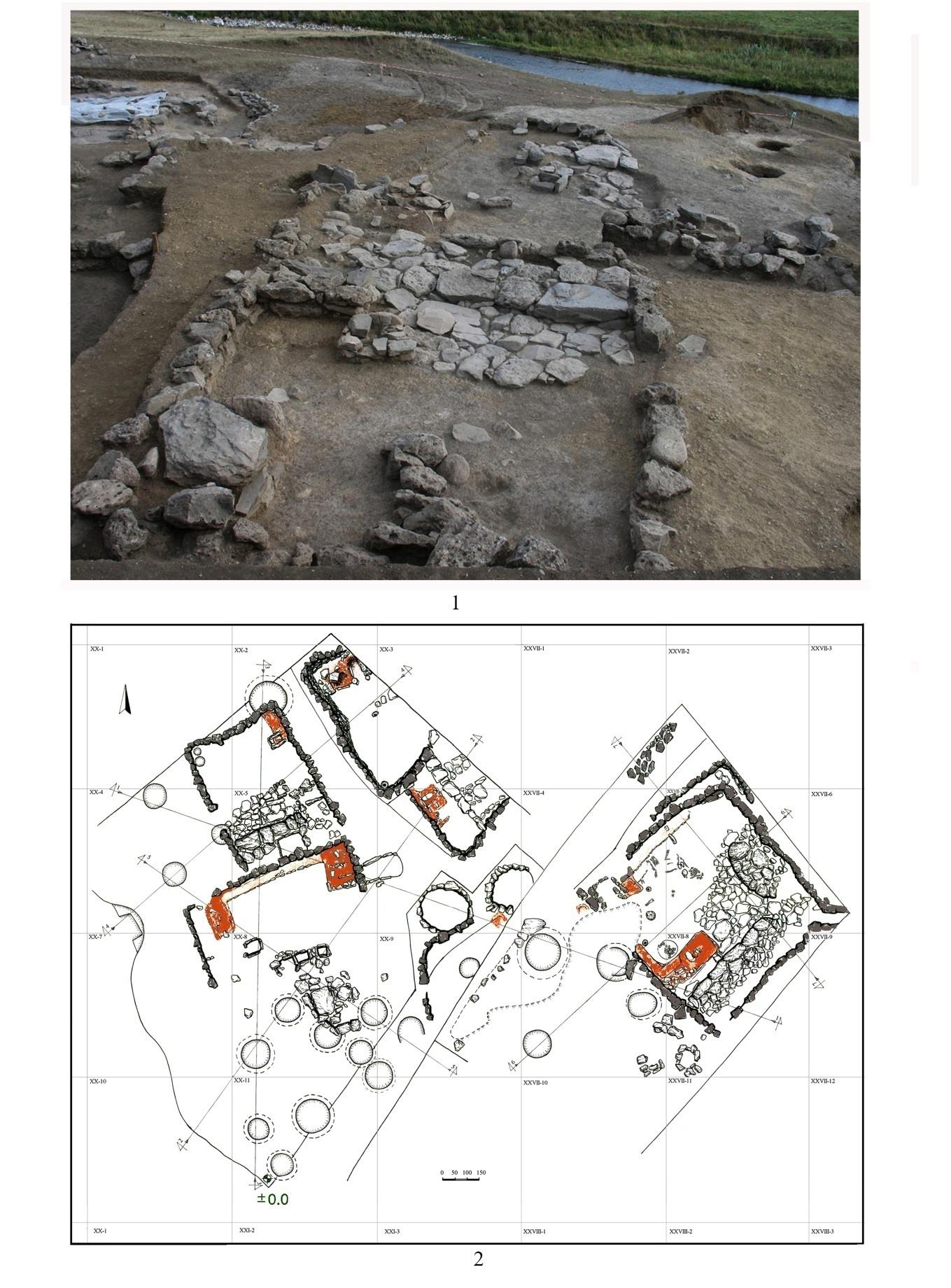
1. Darakoi settlement. In the foreground house #5. daraqoi namosaxlari. wina planze #5 saxli. 2. Darakoi settlement. Houses ## 1-7, Plan. daraqoi. ##1-7 saxlebi. gegma.
III
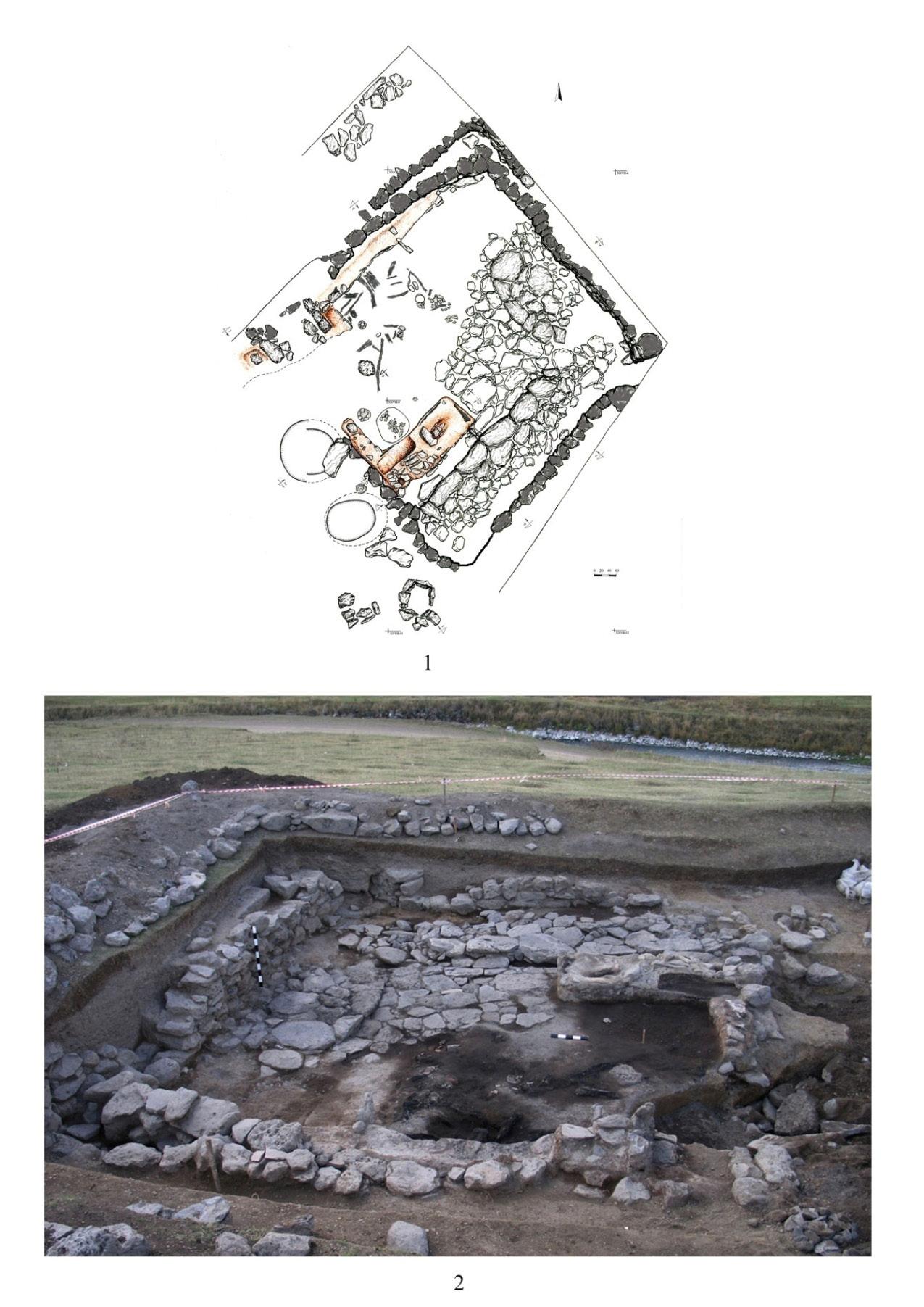
Darakoi settlement: 1. House #1, Plan; 2. View of house #1 from the north. daraqois namosaxlari: 1. #1 saxli. gegma; 2. #1 saxlis xedi CrdiloeTidan.
IV
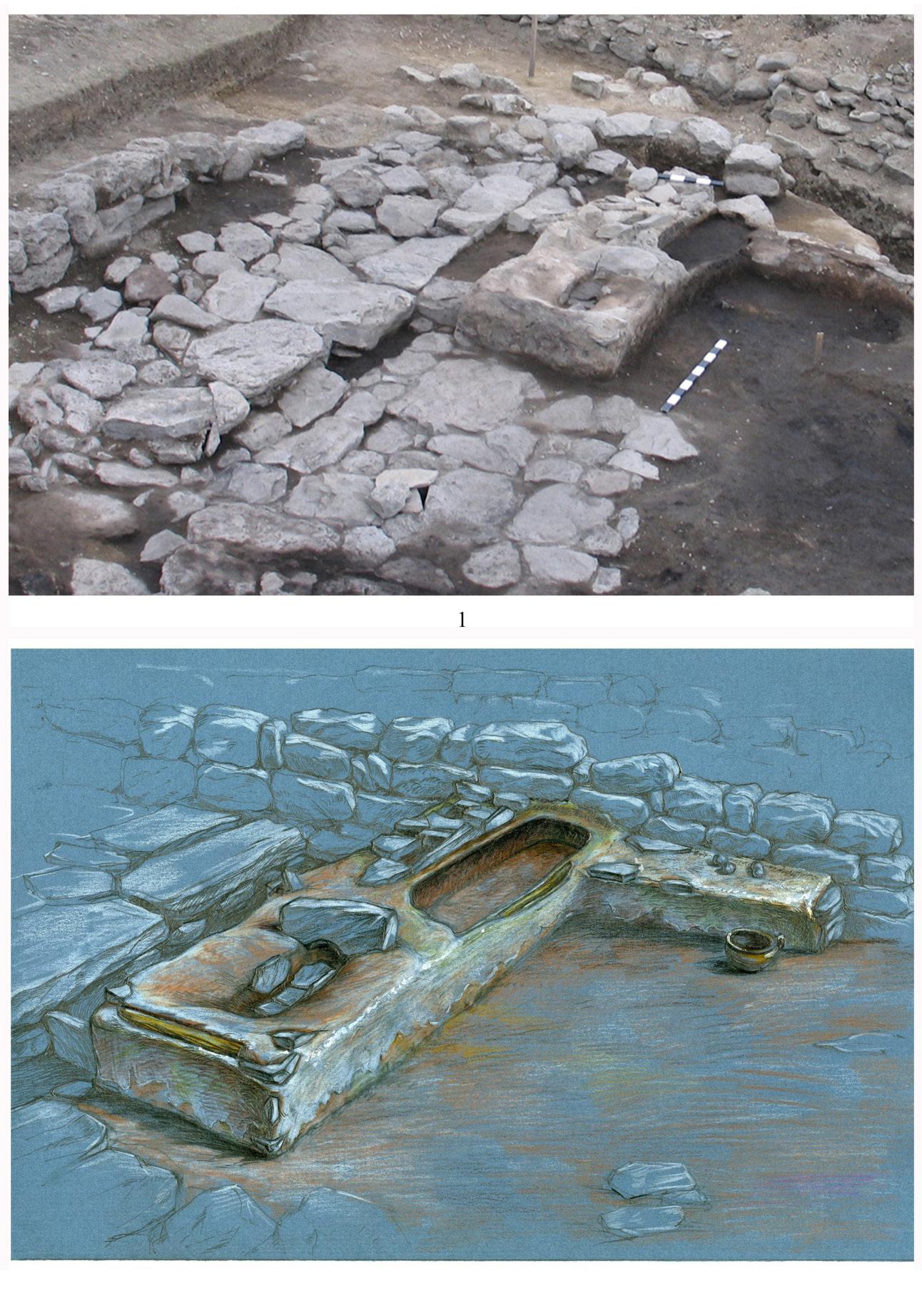
Darakoi settlement: 1. House #1, altar. 2. House #5, altar, drawing.
daraqois namosaxlari: 1. #1 saxli. sakurTxeveli; 2. #1 saxli. sakurTxeveli. Canaxati.
V

Darakoi settlement: 1. House #5; 2. House # 5, stratigraphy of the oven; 3. House # 5, oven, reconstruction.
daraqois namosaxlari: 1. #5 saxli; 2. # 5 saxli. Rumelis stratigrafia; 3. # 5 saxli. Rumeli. rekonstruqcia.
VI
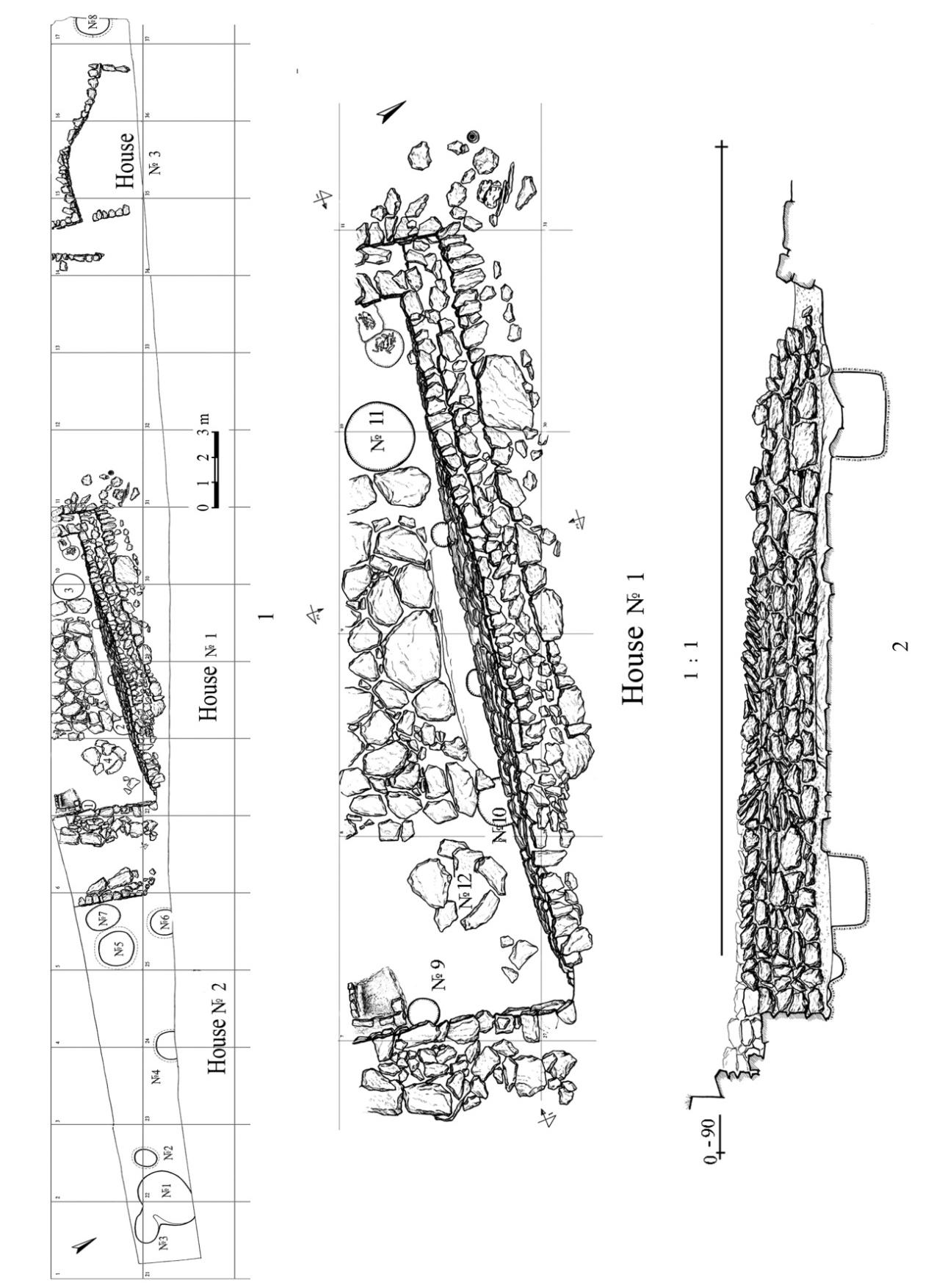
Sakdrioni settlement: 1. General plan; 2. House #1, plan and cut.
saydrionis namosaxlari: 1. gengegma; 2. #1 saxli. gegma da Wrili.
VII

Sakdrioni settlement. 1,2. Altar and sceletons of two piglets; 3. House #1, details.
saydrionis namosaxlari. 1.2. sakurTxeveli da ori goWis ConCxi; 3. #1 saxli. detalebi.

Ai-Ilia settlement: 1. General Plan. 2. House # 1, plan.
ai-ilias namosaxlari: 1. gengegma; 2. # 1 saxli. gegma. VIII
IX
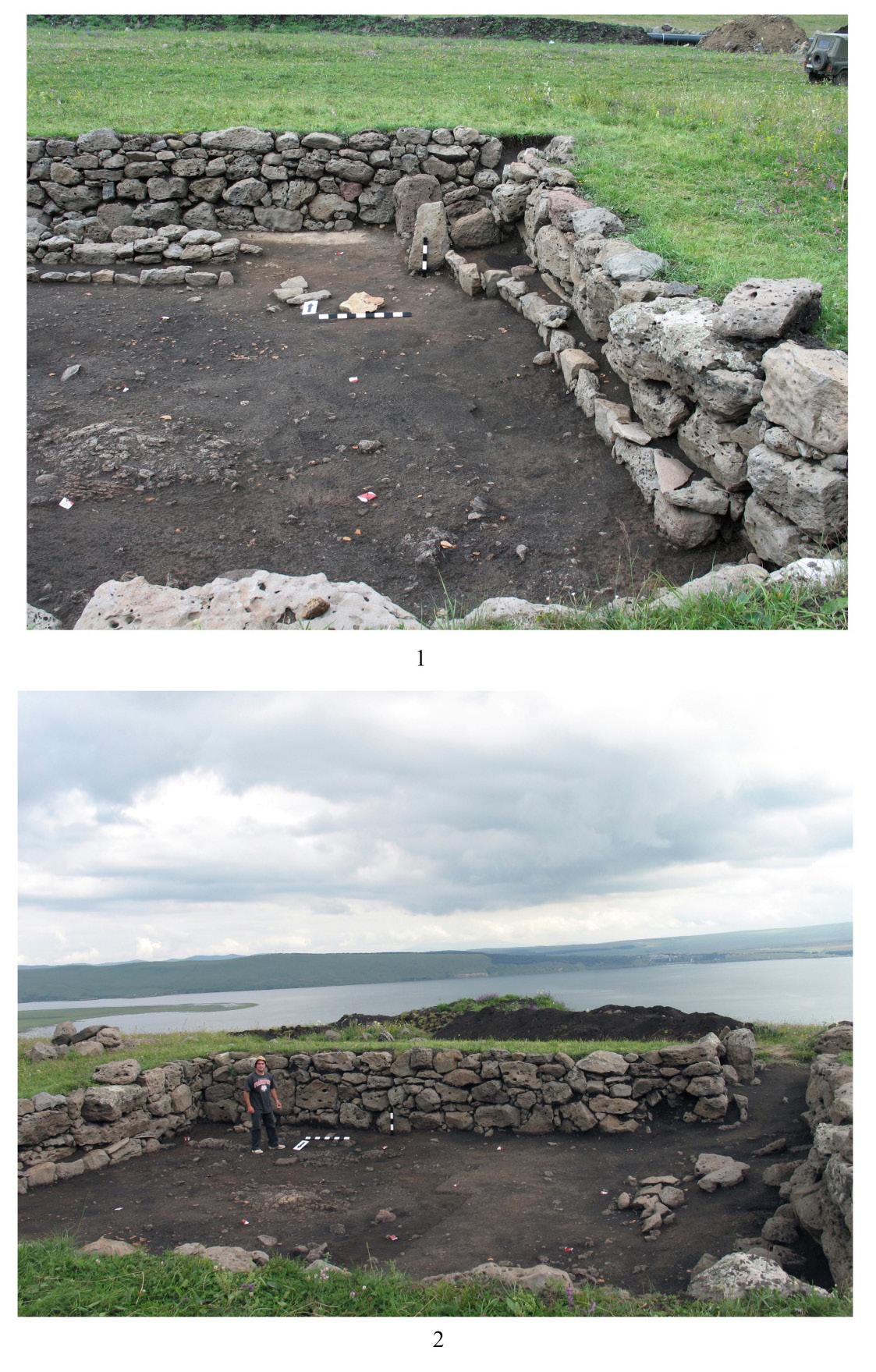
Ai-Ilia settlement: 1. House #1, bench and oven at the northern wall, view form the north-west. 2. House #1, view form the north-west, in the background Tsalka reservoir.
ai-ilias namosaxlari: 1. #1 saxli. CrdiloeT kedelTan gamarTuli savarZeli da Rumeli. xedi samxreT-aRmosavleTidan; 2. #1 saxli.
X
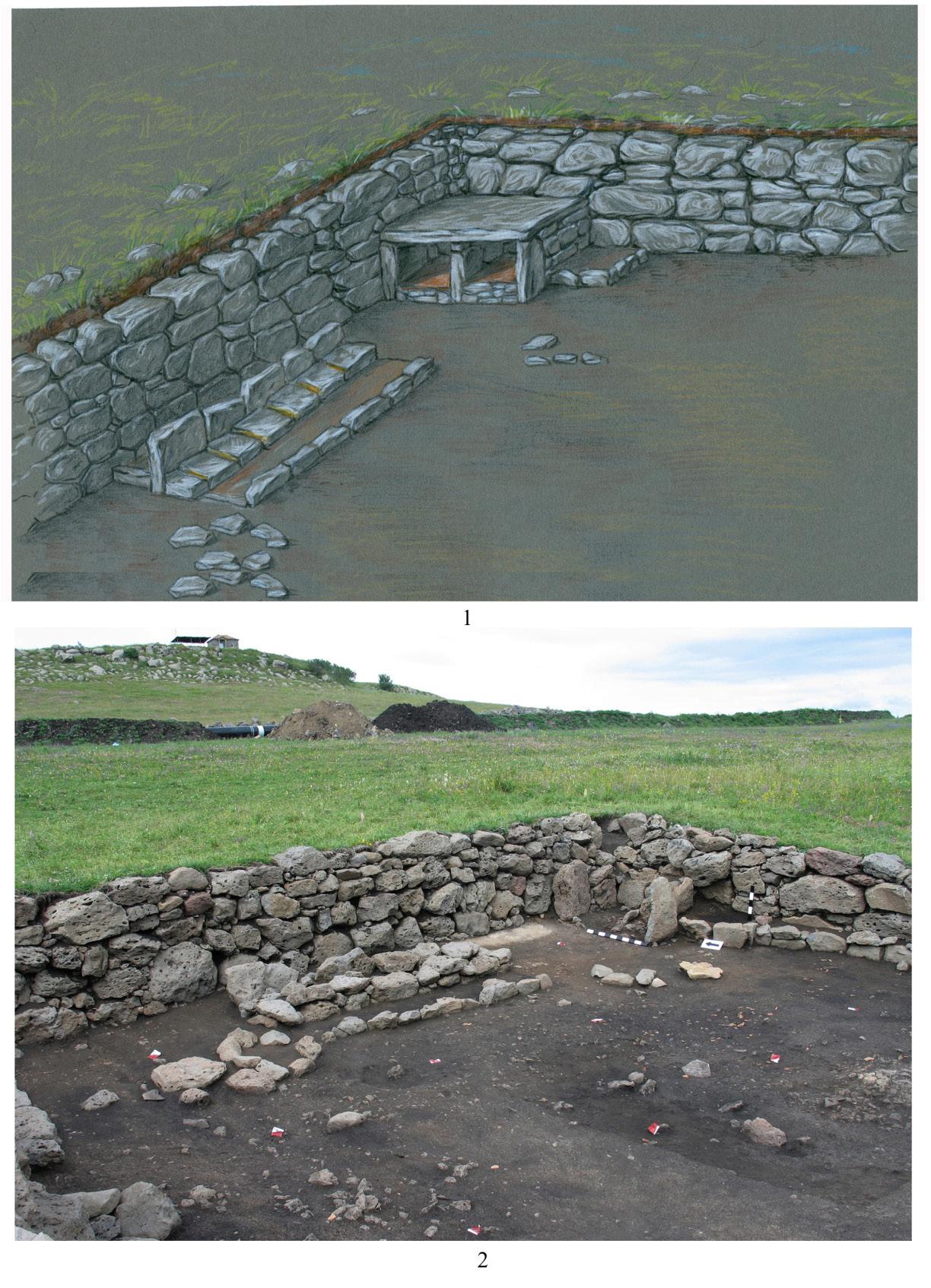
Ai-Ilia settlement: 1. House # 1, oven, reconstruction. 2. House # 1, bench and oven at the northern wall.
ai-ilias namosaxlari: 1. # 1 saxli. Rumeli. rekonstruqcia; 2. # 1 saxli. CrdiloeT kedelTan gamarTuli merx da Rumeli.




